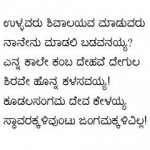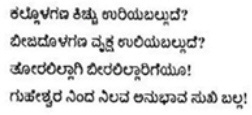By Kollengode S Venkataraman
Veerashaivaas, also known as Lingaayats, are the followers of a strong reform movement of the 12th century, and are in large numbers in the Indian states of Karnataka, Maharashtra and parts of Andhra Pradesh and Tamil Nadu. The movement’s founders defied the Hindu orthodoxy of that era by rejecting the ossified birth-based varna system of society then in existence. In the monotheistic Veerashaiva tradition, as with other Hindu traditions, everyone is a repository of Divinity, which one needs to experience through individual effort and bhakti without the need for an intermediary, like a priest. It also rejected the propitiatory and compensatory rituals.
Being egalitarian at its core, the Veerashaiva Movement did not differentiate people based on birth (caste), creed, gender, or language. That the Lingaayats eventually became a caste by themselves is an ironic twist on how reform movements work in India.
The Lingaayat teachings are in vachanas, meaning “sayings,†rendered in Kannada. The vachanas of Veerashaiva thinkers — Basava Anna (Basava, the elder brother), Mahadevi Akka (Mahadevi, the elder sister), Allama Prabhu, among others — are well-known. Like the writings of the Tamil Bhakti poets who preceded them between the 5th and 10th centuries, Veerashaiva thinkers wrote in the native language Kannada for the understanding of their message by everyone.
The vachana composers addressed their sayings to the presiding deity in the Shiva temple of their choice, like the Tamil Bhakti poets between 6th and 10th centuries. The vachanas are pithy and sometimes cryptic, needing commentaries. The vachana literature continues to influence life in Karnataka and other places.
Starting in the late 19th and 20 centuries, the Lingaayats’ contribution to school and college education throughout Karnataka is significant.
Here are two examples of vachanas. The first one by Basava (1134-1196) is simple, yet profound in its meaning.
 Â Â Â Â Â Â Â Â Â Â Â Â Â Â Â Â Â Â Â Â Â Â Â Â Â Â Â Â Â Â Â Â Â Â Â Â Â Â Â Â Â Â Â Â Â Â Â Â Â Â Â Â Â Â Â Â Â Â The Rich will build temples for Shiva.
                                                                What can I, a poor man, do?
                                          [But then] My legs are the pillars; my body, the temple.
                                           And my head is the golden kalasha, the shining crown.
                          Listen, O, Koodala Sangama Deva (the Deity at the Confluencing Rivers)!
                                             The standing ones decay. The moving ones, never.
                                                          The Rich will build temples for Shiva.
                                                                What can I, a poor man, do?
                                          [But then] My legs are the pillars; my body, the temple.
                                           And my head is the golden kalasha, the shining crown.
                          Listen, O, Koodala Sangama Deva (the Deity at the Confluencing Rivers)!
                                             The standing ones decay. The moving ones, never.
In his travels Basava would have seen dilapidated temples. So he declares, “While the ‘immobile’ ones built with stones and mortar ultimately perish, Shiva lives forever in the hearts of the initiated in each succeeding generation.â€Â Basava calls God’s devotees “walking†temples, identical to what Tirumoolar declared several centuries ago in Tirumandiram, a monumental canonical work containing 3000-plus terse 4-line verses..
Here is a vachana by Allama Prabhu (born 1115 AD) a contemporary of Basavanna. Allama Prabhu’s vachanas are addressed to Guheshawara, which literally means “Ishwara (Divine Being) dwelling in the heart-cave (guha, or guhe in Kannada).
The fire in the stone, can it burn? The tree in the seed, can it make the rustling noise? Being Unseen, he does not appear in flashes to people. The jeeva, in-dwelling one, knows the Guheshwara.Here Allama uses imagery from nature to tell that only with contemplative sensitivity, can one realize the Universal Self within.
When two hard stones rub against each other, the friction leads to sparks that can ignite fire in dry leaves. Caught up in our daily pursuits, we never recognize this potential for fire in simple rocks lying around.
Similarly, we do not see that a seed has within itself the potential for a fully grown tree whose leaves rustle in gentle breeze in summer. We plant a seed. It sprouts, becomes a small plant, eventually growing into a big tree with thick foliage. On a hot summer evening in the gentle cool breeze, the leaves rustle, making gentle whispers.
Using these imageries, Allama declares that only the in-dwelling jeeva can recognize the Infinite One within, the same One which pervades everything around us. But to recognize this, we need to first see the divinity within ourselves even in the midst of our daily grind.
—  By Kollengode S Venkataraman. The author acknowledges Nayantara Swamy from Florida and Lata Mallikarjuna from Monroeville for their help with his rusty Kannada.          – April 2013

